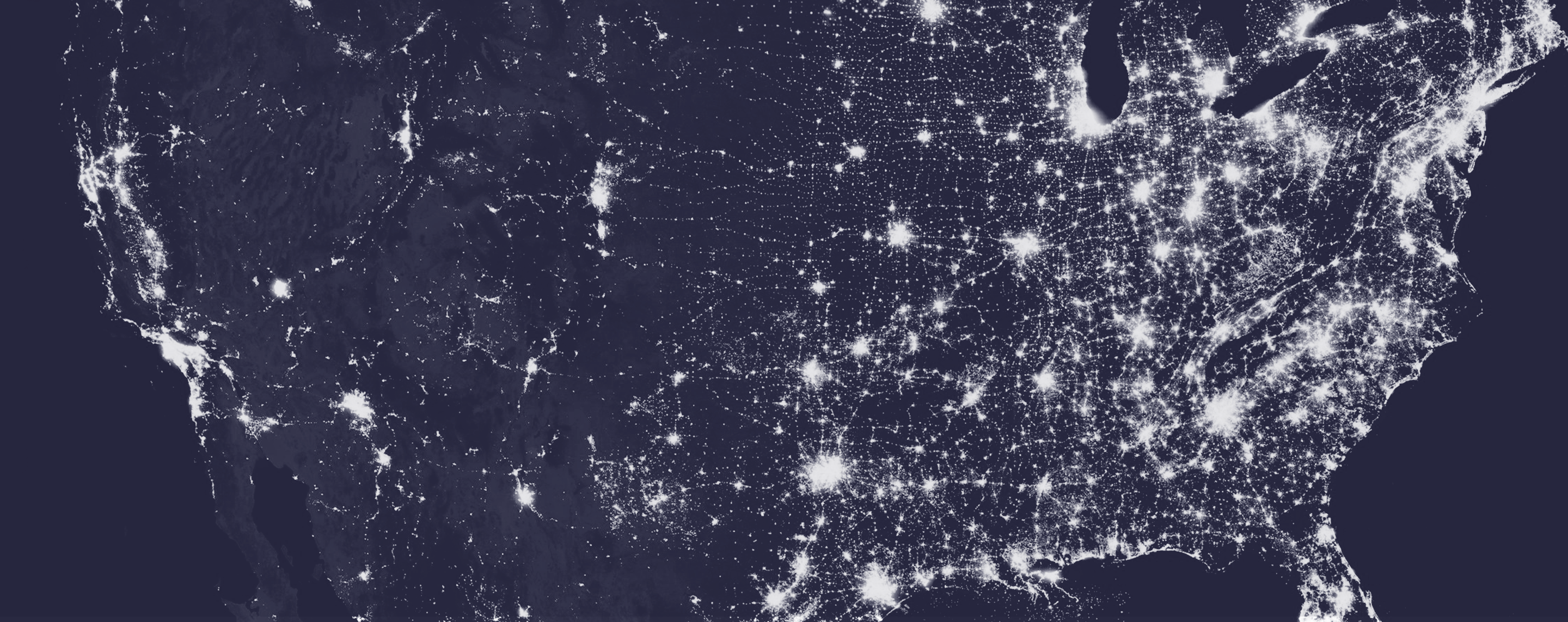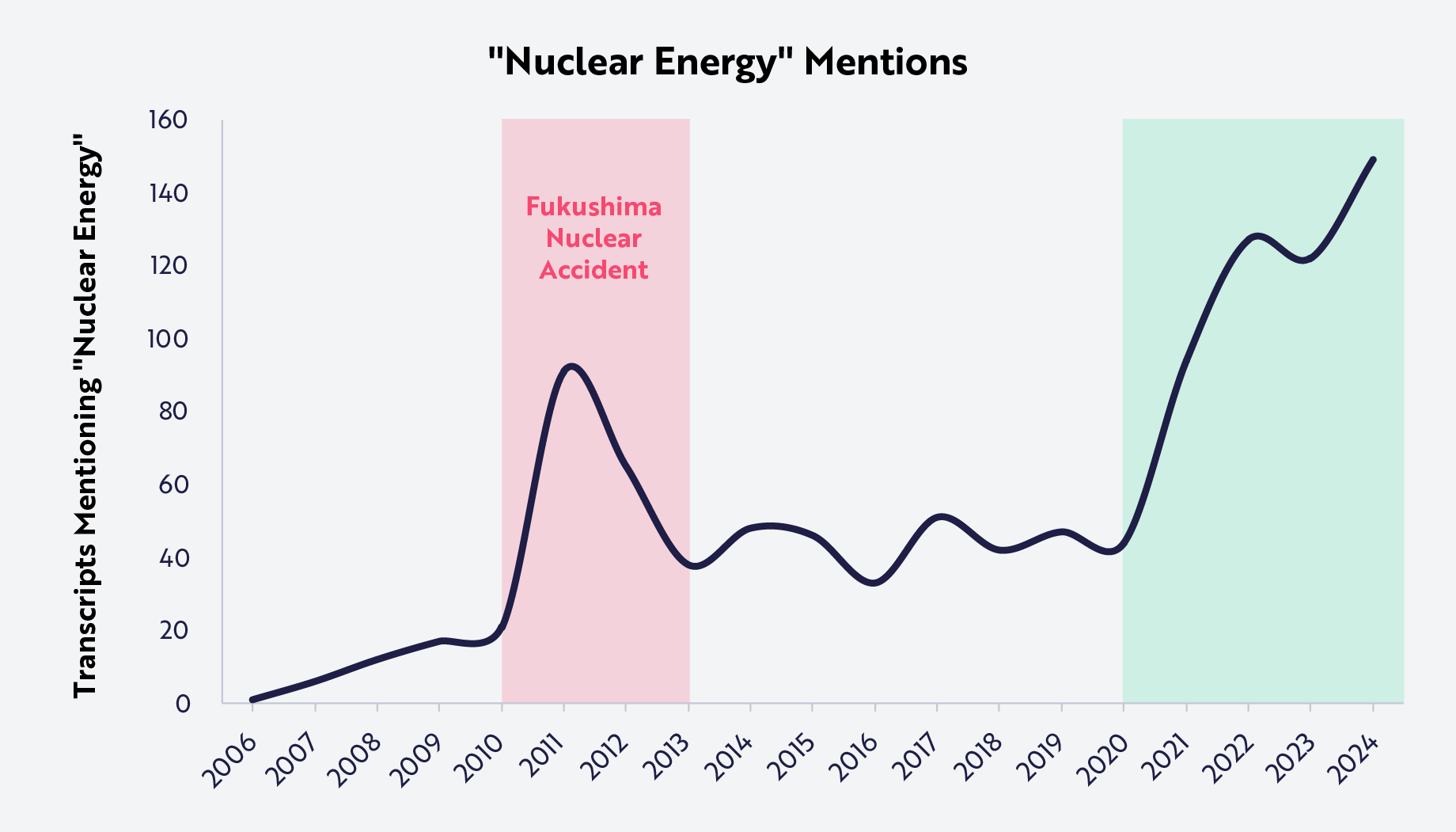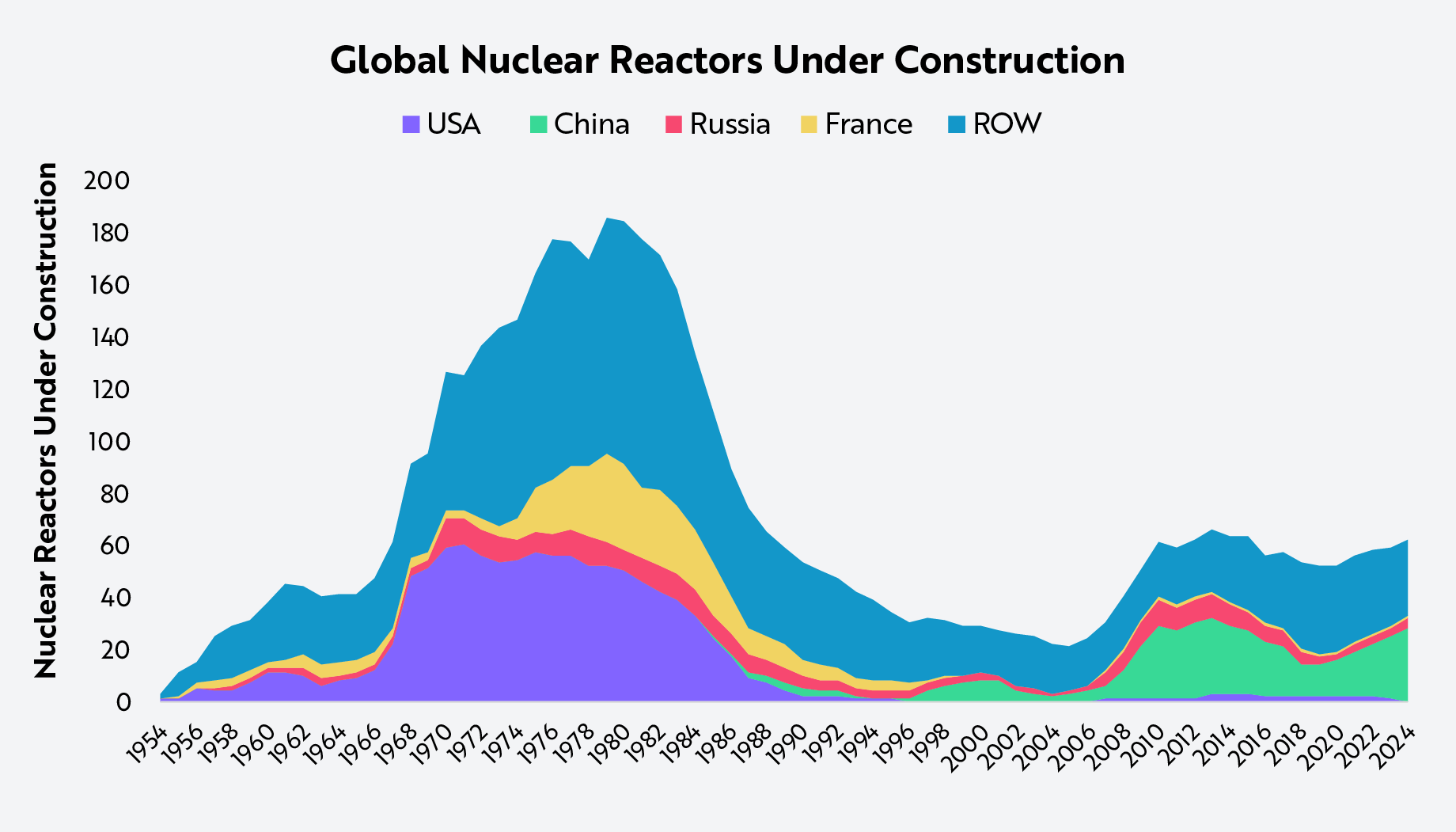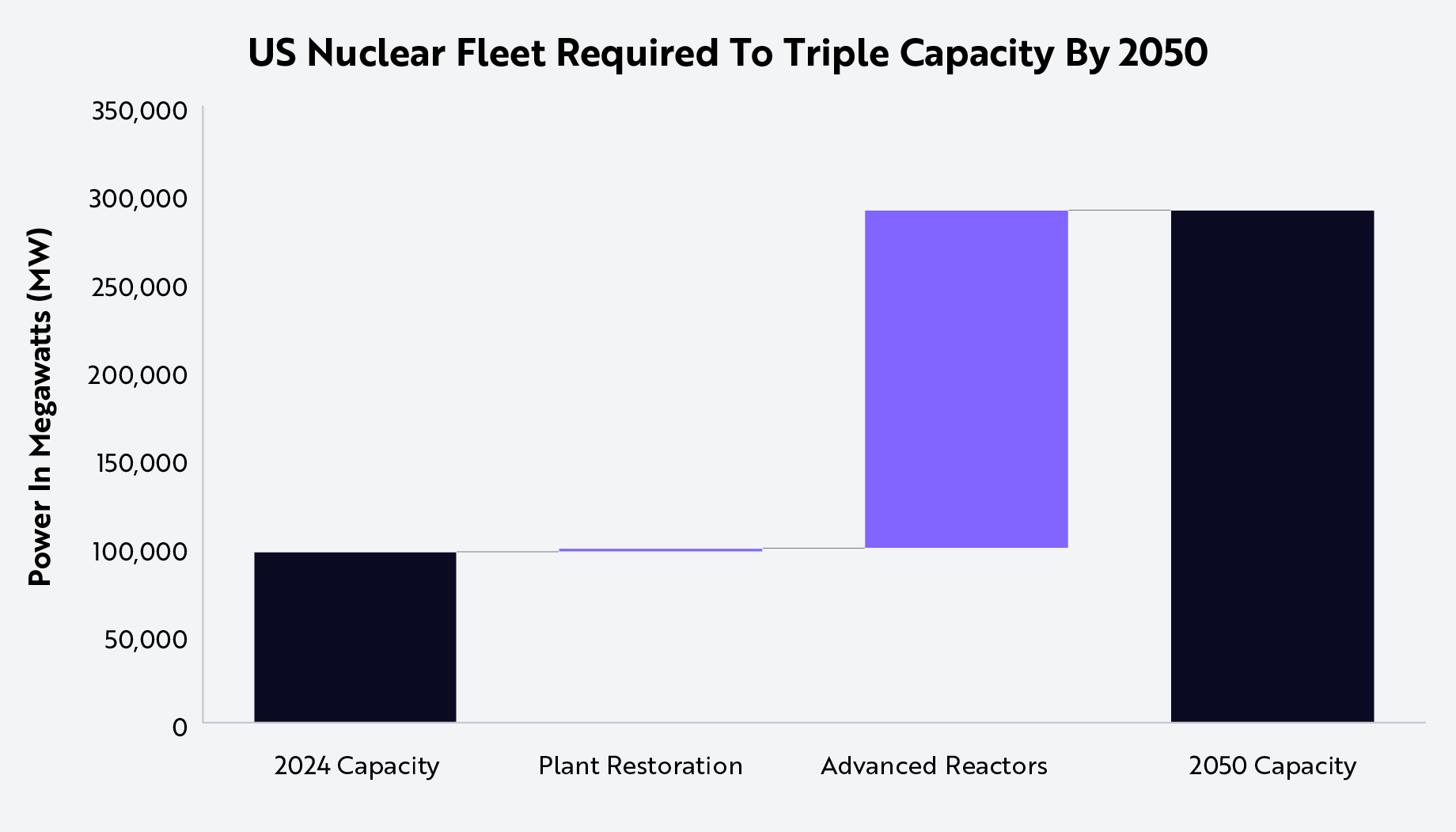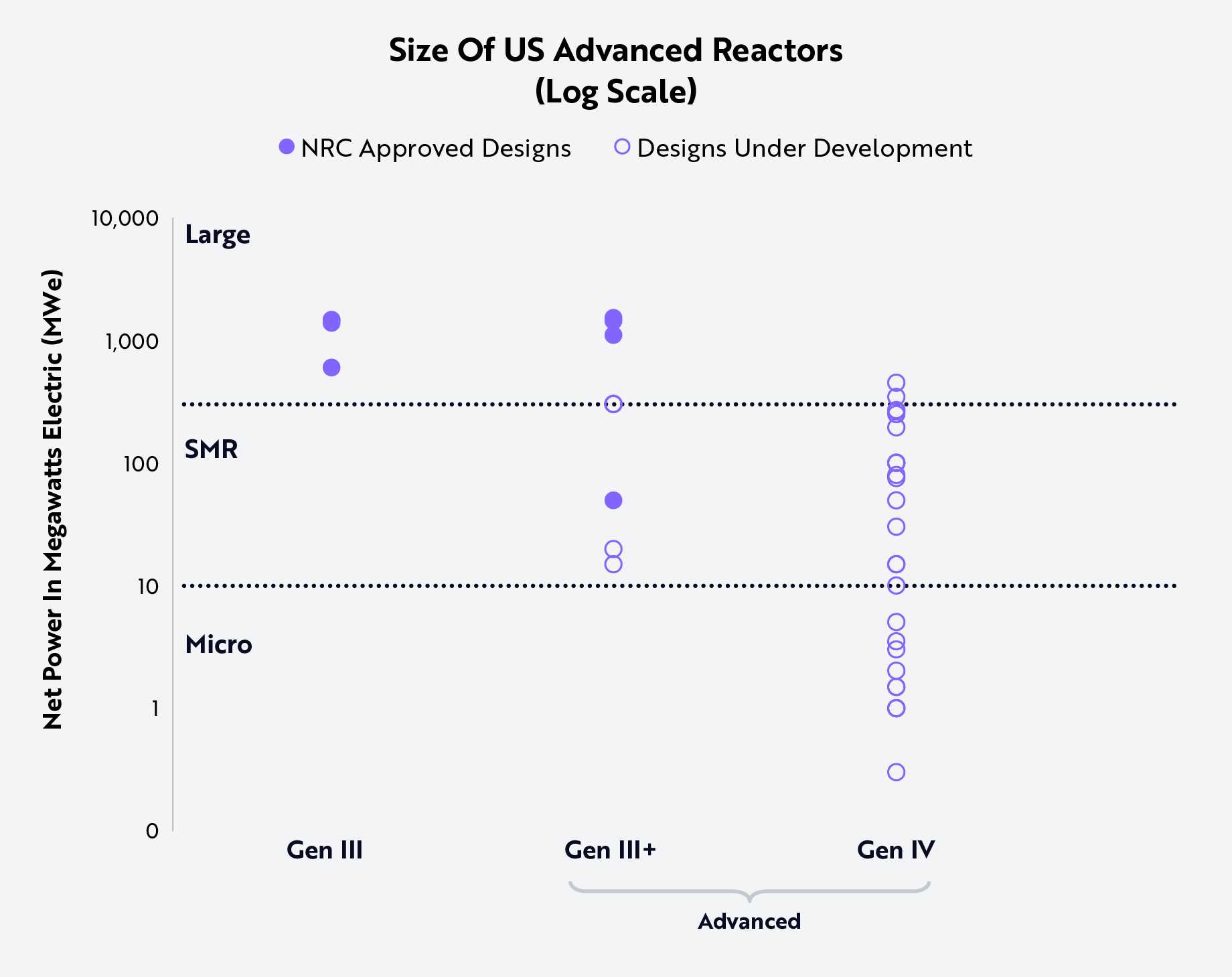By:Daniel Maguire, ACAThe nuclear industry is transforming rapidly as the US and 30 other nations commit to tripling nuclear capacity by 2050.1Hyperscalers like Microsoft, Google, and Amazon are catching the nuclear energy wave in an attempt to meet the rising power demands associated with Artificial Intelligence (AI).2Commitments to net-zero carbon emissions have spurred new and renewed interest in nuclear energy, as shown below. ARK’s research suggests that the US must deploy microreactors, Small Modular Reactors (SMRs), and large-scale reactors to triple nuclear capacity by 2050.
Source: ARK Investment Management LLC, 2025, based on data from Capital IQ Pro as of December 18, 2024. For informational purposes only and should not be considered investment advice or a recommendation to buy, sell, or hold any particular security.
For fifty years, excessive regulation has hampered the development of nuclear energy, leading to cost overruns and delays. Our research shows that regulatory hurdles instituted during the 1970s3derailed the decline in US nuclear construction costs projected by Wright’s Law.4That regulatory derailment has deprived the US of its share of global nuclear construction projects—with none currently underway—while countries like China are expanding their nuclear capacity aggressively, as shown below.
Source: ARK Investment Management LLC, 2025, based on data from PRIS 2024.5For informational purposes only and should not be considered investment advice or a recommendation to buy, sell, or hold any particular security.
Today, the US nuclear industry is beginning to revive and could be on the threshold of a renaissance. In July 2024, the ADVANCE Act directed the Nuclear Regulatory Commission (NRC) to streamline licensing,6and now the Department of Energy (DoE) is investing billions in nuclear energy. Meanwhile, as AI boosts demand for power, hyperscalers like Meta Platforms, Alphabet, Amazon, and Microsoft seem willing to pay higher rates for power purchase agreements (PPAs)7to fund first-of-a-kind (FOAK) designs. As risk capital encourages new designs and regulators lower hurdles to innovation, Wright’s Law suggests that the cost competitiveness of nuclear power will be restored, ultimately lowering electricity prices and reigniting the powerful trends aborted by regulation in 1974.8
To triple capacity by 2050, the US must add ~200 gigawatts (GW) of nuclear power. By 2035, the US plans to deploy 35GW and then add 15GW per year by 2040.9Some older reactors may restart,10but advanced reactors are likely to be the primary path to expansion, as shown below. Moreover, the US must invest heavily in the nuclear supply chain to reduce reliance on Russian imports.11
Note: 2024 capacity assumes that Diablo Canyon remains operational, and all existing fleets renew licenses where applicable. Source: ARK Investment Management LLC, 2025, based on data from IAEA PRIS Power Reactor Information System 2025 and World Nuclear News 2024, 2025.12For informational purposes only and should not be considered investment advice or a recommendation to buy, sell, or hold any particular security.
Advanced reactors are designs—ranging in size from microreactors to SMRs to large-scale reactors—that offer better efficiency, safety, and versatility than conventional reactors.13Currently, the US is developing more than 30 advanced reactor designs, as shown below.
Source: ARK Investment Management LLC, 2025. This ARK analysis draws on a range of external data sources as of December 31, 2024, which may be provided upon request. For informational purposes only and should not be considered investment advice or a recommendation to buy, sell, or hold any particular security.
While SMRs seem to be attracting the most attention, our research suggests that a mix of microreactors, SMRs, and large-scale reactors will be essential to tripling capacity. Smaller reactors with shorter construction times and modular designs have the potential to help meet near-term demand, particularly defense and behind-the-meter applications, as shown below.
Microreactor Small Modular Reactor Large-Scale Reactor Size (In MW) ~1-10 ~11-300 >300 Use Case Defense/Behind-The-Meter Behind-The-Meter/Grid-Connected Grid-Connected Deployment Time* Weeks ~1-3 Years ~6-8 Years Example Company Radiant Oklo Westinghouse *Microreactor and Small Modular Reactor timelines are estimates. Large-scale reactors have historically taken ~6-8 years on average to construct. Source: ARK Investment Management LLC, 2025. This ARK analysis draws on a range of external data sources as of February 25, 2025, which may be provided upon request. Forecasts are inherently limited and cannot be relied upon. For informational purposes only and should not be considered investment advice or a recommendation to buy, sell, or hold any particular security.
Longer term, as they have since the 1950s, large-scale reactors are likely to provide most of the reliable baseload power to the US grid. Selecting and iterating on a few key designs from more than 30 options in the US will help reignite the cost declines associated with Wright’s Law, ultimately lowering electricity prices.
In our view, the geopolitical landscape today is much like that of the 1950s, including concerns about excessive regulation and losing a global nuclear race. Industry and government collaborated to create a surge in nuclear plant construction in the 1960s.14Now, with bold targets, rising demand, and advanced reactors nearing deployment, the US has another opportunity to act decisively and reclaim its leadership in the nuclear energy race.
- 1
World Nuclear News. 2024. “More countries sign declaration to triple nuclear capacity.”
- 2
McCormick, M. and J. Smyth. 2024. “Microsoft in deal for Three Mile Island Nuclear Power to Meet AI Demand.” Financial Times. Moore, M. 2024. “Google Orders Small Modular Nuclear Reactors for its Data Centres.” Financial Times. Smyth, J. 2024. “Amazon Buys Stake in Nuclear Energy Developers in Push to Power Data Centres.” Financial Times.
- 3
Maguire, D. 2024. “Nuclear Energy Could Contribute Meaningfully To Securing Net-Zero Emissions.” ARK Investment Management LLC.
- 4
Wright’s Law states that for every cumulative doubling of units produced, costs will fall by a constant percentage. See Winton, B. 2019. “Moore’s Law Isn’t Dead: It’s Wrong—Long Live Wright’s Law.” ARK Investment Management LLC.
- 5
IAEA PRIS Power Reactor Information System. 2025. “The Database on Nuclear Power Reactors.”
- 6
U.S. Nuclear Regulatory Commission. 2024. “ADVANCE Act (Accelerating Deployment of Versatile, Advanced Nuclear for Clean Energy Act of 2024).”
- 7
Freebairn, W. 2025. “Investment in US nuclear power ready to expand: Guggenheim.” S&P Global.
- 8
Korus, S. 2024. “Regulations Have Prevented Electricity Price Declines In The US.” ARK Investment Management LLC.
- 9
Note: The 35GW target by 2035 includes both operational and under-construction capacity. See The White House. President Joe Biden. 2024. “Biden-Harris Administration Establishes Bold U.S. Government Targets for Safely and Responsibly Expanding U.S. Nuclear Energy and Announces Framework for Action to Achieve these Targets.”
- 10
That process already is underway. See World Nuclear News. 2024. “Constellation to restart Three Mile Island unit, powering Microsoft.” World Nuclear News. 2024. “Palisades on schedule for repowering, NRC considers restart regulations.” World Nuclear News. 2025. “NextEra initiates regulatory process to restart Duane Arnold.”
- 11
118th Congress of the United State of America (2023-2024). 2023. “H.R.1042 - Prohibiting Russian Uranium Imports Act.” Congress.Gov.
- 12
IAEA PRIS Power Reactor Information System. 2025. “The Database on Nuclear Power Reactors.” World Nuclear News. 2024. “Constellation to restart Three Mile Island unit, powering Microsoft.” World Nuclear News. 2024. “Palisades on schedule for repowering, NRC considers restart regulations.” World Nuclear News. 2025. “NextEra initiates regulatory process to restart Duane Arnold.”
- 13
U.S. Department of Energy. 2025. “Enhanced Safety of Advanced Reactors.”
- 14
Walker, J.S. and T. Wellock. 2024. “A Short History of Nuclear Regulation, 1946–2024.” U.S. Nuclear Regulatory Commission.
- Forums
- ASX - By Stock
- SLX
- Nuclear Power Related Media Thread
SLX
silex systems limited
Add to My Watchlist
23.9%
 !
$3.99
!
$3.99
Nuclear Power Related Media Thread, page-6267
Featured News
Add to My Watchlist
What is My Watchlist?
A personalised tool to help users track selected stocks. Delivering real-time notifications on price updates, announcements, and performance stats on each to help make informed investment decisions.
 (20min delay) (20min delay)
|
|||||
|
Last
$3.99 |
Change
0.770(23.9%) |
Mkt cap ! $950.0M | |||
| Open | High | Low | Value | Volume |
| $3.47 | $4.01 | $3.43 | $11.26M | 2.928M |
Buyers (Bids)
| No. | Vol. | Price($) |
|---|---|---|
| 2 | 8973 | $3.92 |
Sellers (Offers)
| Price($) | Vol. | No. |
|---|---|---|
| $4.00 | 9643 | 4 |
View Market Depth
| No. | Vol. | Price($) |
|---|---|---|
| 2 | 8973 | 3.920 |
| 1 | 300 | 3.900 |
| 1 | 10793 | 3.880 |
| 2 | 7651 | 3.870 |
| 2 | 12778 | 3.850 |
| Price($) | Vol. | No. |
|---|---|---|
| 4.000 | 9643 | 4 |
| 4.010 | 1512 | 1 |
| 4.020 | 2000 | 1 |
| 4.030 | 2836 | 3 |
| 4.040 | 8772 | 1 |
| Last trade - 16.10pm 16/06/2025 (20 minute delay) ? |
Featured News
| SLX (ASX) Chart |
